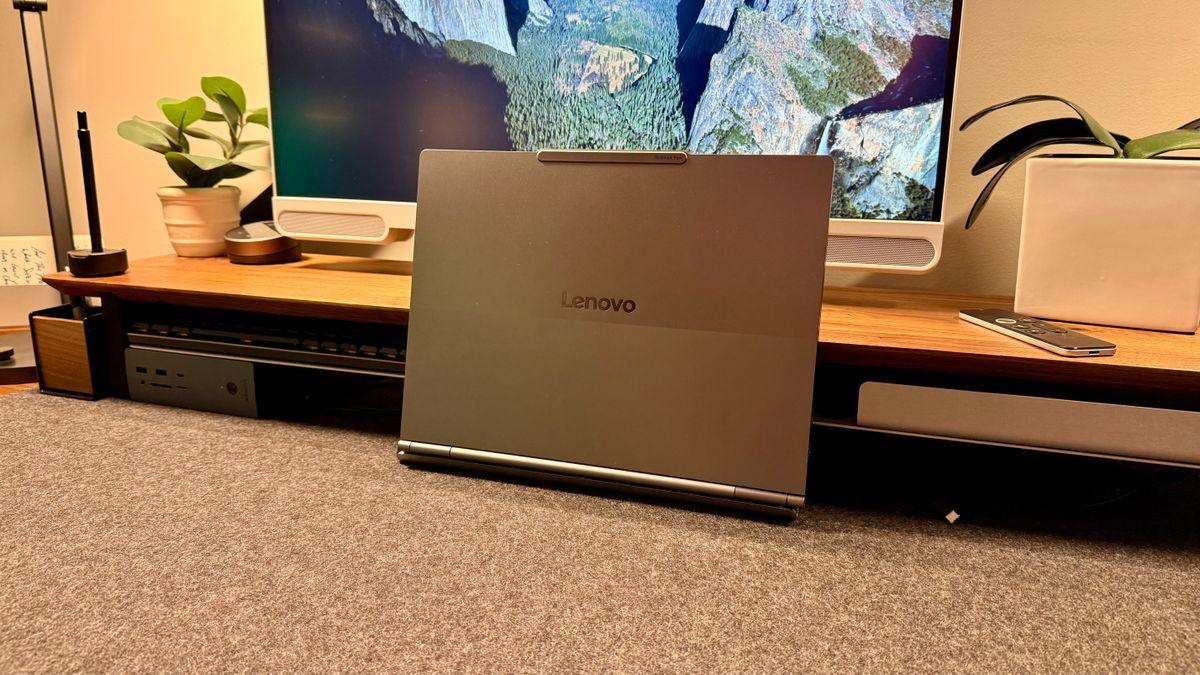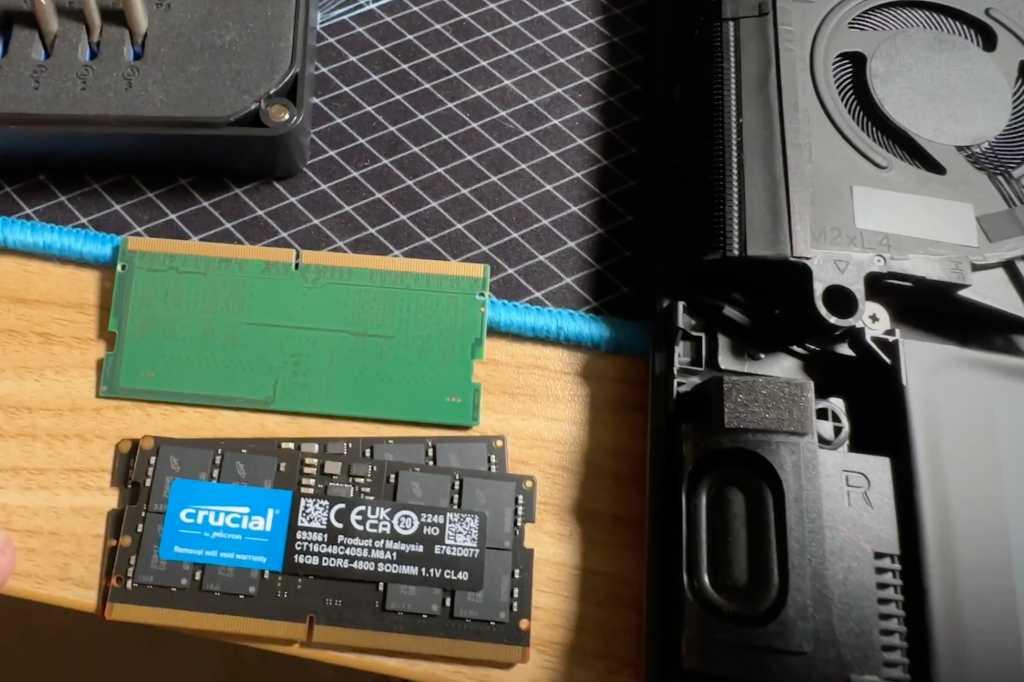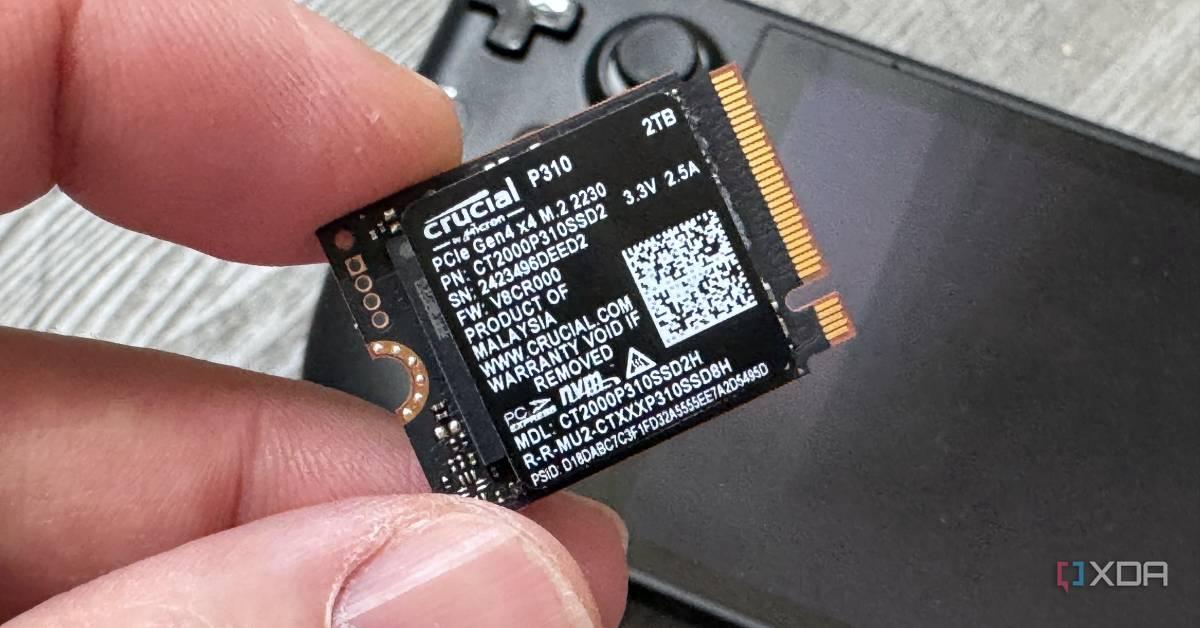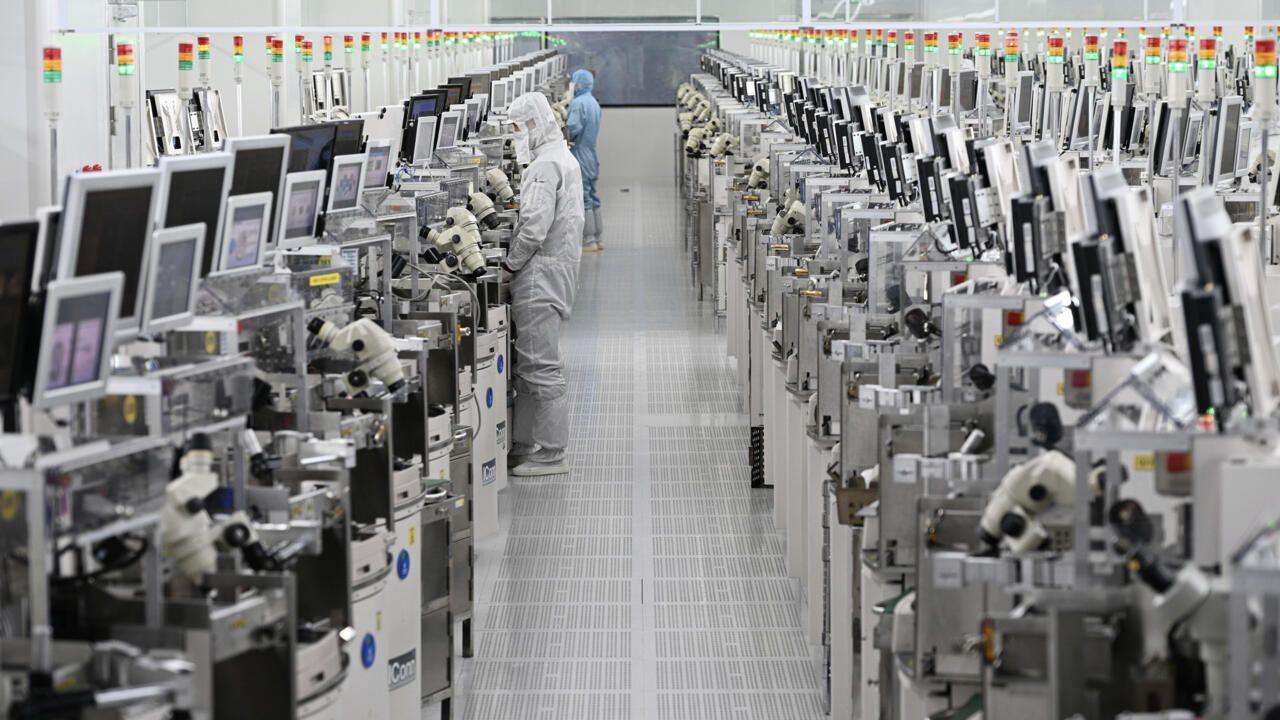Lenovo Stockpiles Memory Components as AI Boom Creates 'Unprecedented' Supply Crunch
7 Sources
7 Sources
[1]
Lenovo Stockpiling PC Memory Due to 'Unprecedented' AI Squeeze
Lenovo Group Ltd. is stockpiling memory and other critical components to navigate a supply crunch brought on by the boom in artificial intelligence. The world's biggest PC maker is holding on to component inventories that are roughly 50% higher than usual, Chief Financial Officer Winston Cheng told Bloomberg TV on Monday. The frenzy to build and fill AI data centers with advanced hardware is raising prices for producers of consumer electronics, but Lenovo also sees opportunity in this to capitalize on its stockpile.
[2]
Lenovo stockpiles RAM to (hopefully) keep laptop prices down
The world's biggest PC maker is hoping to use its economic might to weather the memory capacity crunch. Hey, so.... RAM is getting crazy expensive at the moment. Thanks to a memory supply crunch mostly attributed to the "artificial intelligence" boom and a huge increase in data center demand, prices for consumer-level RAM are so out of control that electronics stores are pricing them like lobster. Lenovo is reportedly stockpiling memory, hoping to avoid huge price changes for its consumer PCs. That's the word out of Bloomberg, citing an interview with Lenovo's Chief Financial Officer Winston Cheng. He says that the demand is "unprecedented," which is why prices on consumer memory are jumping up to stratospheric levels, 100 percent or more in just the last couple of months. Lenovo also says it's stockpiling other "critical components," probably including microcontrollers and storage. The company estimates that it has enough memory to keep it supplied through 2026. With over a quarter of the worldwide market, Lenovo is the largest PC manufacturer by a healthy margin, though brands like Apple, HP, and Dell are more visible outside of China. With that kind of muscle, Lenovo can use economies of scale to cushion itself from the most extreme shifts in the market. But unpredictable impacts such as US president Trump's seemingly random application of tariffs and other import taxes can still throw big companies for a loop. Laptops, desktops, phones, tablets, and pretty much everything else that you can broadly call a computer will certainly get more expensive if data center rollout doesn't slow, as demand for "AI" machine learning and large language model capacity balloons into a worrying economic bubble. Consumers who want to buy their own RAM and storage are getting the worst of it, as suppliers and retailers pass costs down the line. Some consumer-grade DDR5 modules are doubling or even tripling in price at the moment. Despite the consumer frenzy around Black Friday and holiday shopping, it's a bad time to upgrade your PC if you're hoping to save money.
[3]
Massive AI demand forces Lenovo into aggressive memory hoarding
Traditional memory output shrinks while global pricing pressure intensifies rapidly Lenovo has confirmed it is stockpiling memory chips and other essential components in response to a tightening global supply chain pushed by artificial intelligence demand. The company's leadership described the situation as an unprecedented AI squeeze, with accelerated buying from data center operators and cloud platforms constraining availability. Lenovo's inventory levels are now approximately 50% higher than normal, affecting its entire range of devices, including the mini PC segment. The spike in memory prices is tied to a broader shift within the semiconductor industry. Major producers, including Samsung and SK Hynix, have diverted significant manufacturing capacity toward high-bandwidth memory, which is used for AI servers. This transition has reduced the output of traditional memory chips typically used in consumer PCs, smartphones, and gaming devices. As a result, global memory prices have climbed steadily in recent months, affecting manufacturers across the electronics industry. This situation is already influencing several product lines, particularly systems aimed at business laptop buyers who depend on stable component availability. Lenovo executives said the buildup is part of a longer-term plan to avoid disruptions through 2026. The company recently signed long-term supply agreements meant to secure memory availability throughout next year Its CEO also stated the firm believes these arrangements represent optimal contracts under current conditions. "We signed the optimal contract with key component suppliers to ensure we have enough supply for next year," Yang Yuanqing said. "Overall, we do not see a bubble because the next stage will be AI democratization." Lenovo acknowledged higher memory costs could raise the prices of consumer electronics in the upcoming quarters, noting AI-related spending had already influenced its recent earnings, with additional costs partially offsetting steady PC and device sales. Despite that, Lenovo said it aims to maintain sales momentum and avoid passing rising component prices directly to consumers whenever possible. Other firms, including Xiaomi, warned that smartphone buyers may face increased prices next year due to the same supply constraints. That said, Lenovo's latest financial results showed revenue growth and improved adjusted profit, even as its shares remain lower for the year. However, semiconductor makers expect AI-driven demand to continue shifting production priorities, which could keep supplies tight for traditional memory products. Via Bloomberg
[4]
Lenovo 'Best At Navigating' Looming Memory Shortage: North American President
"These capacities have to be brought online years ago. You have to build these fabs and the energy for this, and the largest hyperscaler models from the largest names, which I won't mention but you know who they are, are all looking to make sure they have the ability to continue their infrastructure. And it has an impact across the entire ecosystem," Ryan McCurdy, Lenovo's senior vice president and president of North America, told CRN. While Lenovo saw record quarterly revenue, a healthy rise in infrastructure sales and continued dominance the PC category during its most recent quarter, the company is turning its full attention to mitigating the memory shortages it sees on the horizon, Lenovo executive Ryan McCurdy told CRN. "We like to think that we're going to be the best at navigating this," said McCurdy, Lenovo's senior vice president and president of North America. "But to do that, you have to be proactive, planning with your partners, with your customers. And this is something we're spending a disproportionate amount of time on, and I think it's going to dominate the narrative in the quarters to come." McCurdy said the market for DRAM and NAND memory are facing the largest supply-demand gap in the last decade, which is likely to lead to a systemic shortage coming across the industry, driven by the large hyperscalers. "It has a downstream effect on every device that uses hard drives and memory, and there's CPU elements to it, and it's all interconnected, and it's very exciting as a supply chain undergrad, but it's also the dominant feature today, and it's all part of that larger narrative," he said. McCurdy (pictured) said the industry is bracing for memory shortages from the data center to the smartphone, which could see DRAM and NAND prices double as device makers vie for time and space in a limited number of chip fabrication plants. "These capacities have to be brought online years ago," he said. "You have to build these fabs and the energy for this, and the largest hyperscalers' models from the largest names, which I won't mention but you know who they are, are all looking to make sure they have the ability to continue their infrastructure. And it has an impact across the entire ecosystem." McCurdy said Lenovo has built a dynamic supply chain that has demonstrated its ability to weather sudden shifts and unknowns, such as trade policy moves around tariffs and global geopolitics. "You've seen us do this over the last few years. We're winning. We have the supply chain. We have the relationships," he said. "Let's talk, let's plan. Let's make sure we navigate this next season." Lenovo's newest channel chief, Wade McFarland, took over 13 weeks ago. He said he has spent much of his time recently talking with distributors and leading partners about how Lenovo plans to mitigate the shortage the company sees on the horizon. "I think we are very well positioned with our partners, but again, I just go back to the way that we collaborate and the way that we're out on our front foot having these conversations before we get to those events, which I think we'll start to really probably see materialize at the beginning of the year," McFarland said. "So I think that's what's helpful, is just being on our front foot and being out there with our partners and navigating through these uncertain times that are heading our way." Lenovo last week reported record revenue of $20.4 billion, up 15 percent year over year for its second quarter in fiscal year 2025/26. Additionally, the company, which is publicly traded on the Hong Kong Stock Exchange, reported net income growth of 25 percent year over year to $512 million. The largest portion of Lenovo's sales, some $15.1 billion, came from its Intelligent Devices Group, which makes PCs, phones, tablets and peripheral devices. That unit grew revenue 12 percent, helped along by demand for AI PCs, which now account for 33 percent of all PC shipments, the company said. The company's infrastructure business notched $4.1 billion in sales, up 24 percent year on year as demand for the company's Neptune line of direct-to-chip liquid-cooled servers saw strong demand from cloud service providers, enterprise and the SMB.
[5]
Lenovo Has Relied on a "Massive" Inventory Buildout to Keep Prices Stable This Year, But Warns of Aggressive Hikes if Memory Shortages Persist Into 2026
Well, it appears that Lenovo has given PC gamers the signal not to worry for this year, but 2026 could prove to be troublesome if memory shortages continue at their current pace. The PC market is entering a 'difficult' period in the upcoming quarters, as the AI bandwagon is moving at a rapid pace, driving demand for memory products to a new high. End-solutions like HBM, DDR, LPDDR, and GDDR memory are entering into shortages, which is why vendors across the consumer supply chain are preparing for aggressive price increases. In a statement by Lenovo's CFO Winston Cheng, it is revealed that the manufacturer had already adjusted to memory shortages by acquiring massive inventory of its products upfront, to ensure that higher costs don't transfer to retailers and consumers. The world's biggest PC maker is holding on to component inventories that are roughly 50% higher than usual, Chief Financial Officer Winston Cheng told Bloomberg TV on Monday. The frenzy to build and fill AI data centers with advanced hardware is raising prices for producers of consumer electronics, but Lenovo also sees an opportunity in this to capitalize on its stockpile. - Bloomberg This massive inventory buildout has ultimately allowed Lenovo to adjust to changes within the supply chain this quarter; however, the company does warn that it may need to implement "adjustments" in 2026, following the ongoing memory supercycle. The official didn't reveal the impact of the ongoing memory shortages on consumer products, but it appears that a vast range of devices will be affected, including laptops and pre-built PCs. Given that Lenovo is one of the largest PC manufacturers, the supply chain will inevitably implement price hikes to combat the uncertainity. Consumer markets have already begun to witness drastic price hikes across products like consumer RAMs, and it is also anticipated that AMD and NVIDIA will implement increases across their GPU offerings as well. Such moves will ultimately impact the broader consumer industry to the point where the majority of computing devices will see noticeable price hikes. Based on reports, it is anticipated that shortages will persist into 2027, so we have a year of supply constraints ahead.
[6]
Lenovo stockpiling PC memory amid AI supply squeeze- Bloomberg By Investing.com
Investing.com-- Lenovo Group (HK:0992), the world's largest PC maker, is stockpiling memory chips amid an unprecedented supply squeeze due to the artificial intelligence industry, CFO Winston Cheng told Bloomberg TV on Monday. The company is stockpiling component inventories that are roughly 50% higher than usual, Cheng said, as outsized memory demand from AI data centers and cloud hardware tightened memory chip supplies and ramped up prices. This trend is also expected to raise the prices of consumer electronics, which could hurt demand for Lenovo's products in the coming quarters. But Cheng said the company also sees an opportunity to capitalize on its high inventories, and will aim to avoid passing on costs to its consumers. The company clocked a mild decline in its September quarter profit last week, as increased spending on AI partially offset strong PC and device sales. Cheng signaled on Monday that the company is seeking to maintain its sales momentum. In a post-earnings call, Lenovo signaled it had enough memory chips for 2026. Global memory chip prices were seen increasing rapidly in recent months, as outsized demand from the AI sector saw major producers Samsung Electronics Co Ltd (KS:005930) and SK Hynix Inc (KS:000660) prioritize making high-bandwith memory chips over traditional ones used in consumer electronics. Top Chinese smartphone maker Xiaomi Corp (HK:1810) had warned this could push up smartphone prices next year.
[7]
AI boom causing global memory crisis, warn Dell, HP and Lenovo
Tech giants warn of escalating costs as AI shifts chip production The artificial intelligence revolution was promised to change everything, from how we work to how we discover new medicines. But as 2025 draws to a close, the "AI boom" is delivering an unexpected and costly side effect: a global squeeze on the memory chips that power everyday electronics. Major technology titans including Dell Technologies, HP Inc., and Lenovo are now sounding the alarm. They warn that the insatiable appetite for AI infrastructure is cannibalizing the world's supply of memory chips, setting the stage for a pricing surge that will hit everything from budget laptops to high-end smartphones. Also read: Nvidia vs Google: Why Jensen Huang is attacking 'inflexible' TPUs A capacity crunch At the heart of the crisis is a zero-sum game of manufacturing capacity. To train massive AI models like GPT-5 or Claude, data centers require specialized, high-performance silicon, specifically, High Bandwidth Memory (HBM). These chips are complex, profitable, and difficult to manufacture. This seems to be a "displacement effect." Every wafer Samsung, SK Hynix, or Micron dedicates to HBM for an AI server is effectively removed from the production line for standard DRAM used in laptops or NAND flash for phones. Because chipmakers cannot build new billion-dollar fabrication plants overnight, they are shifting existing production lines to chase the high-margin AI gold rush. The result? A dwindling supply of the "boring" but essential chips that the rest of the tech world runs on. The view from the C-Suite The warnings from industry leaders have shifted from cautious to urgent in recent weeks. Dell Technologies Chief Operating Officer Jeff Clarke didn't mince words on a recent call with analysts. He noted that the company has "never seen costs move at the rate" they are currently rising. For Dell, the cost basis is climbing across the board, not just for high-end server chips, but for the standard components that go into office PCs. Also read: Five big upgrades in Claude Opus 4.5 you should know about HP Inc. is bracing for a similar impact. CEO Enrique Lores has flagged the second half of 2026 as a particularly challenging period, indicating that the company may have no choice but to raise prices. The company is currently scrambling to secure more suppliers to mitigate the blow. Meanwhile, Lenovo is taking defensive action. The world's largest PC maker has begun stockpiling inventory, reportedly holding 50% more chips than usual to insulate itself, and its customers, from the coming shock. Consumers face a costly ripple effect For the average consumer, this supply chain drama will likely manifest in a simple, painful way: sticker shock. Analysts at Counterpoint Research forecast that memory module prices could jump by as much as 50% through the first half of 2026. Since memory accounts for a significant chunk of a device's bill of materials - roughly 15% to 18% of a typical PC's cost - retail prices are poised to climb. The impact won't be limited to computers. Smartphone manufacturers like Xiaomi have also warned of rising component costs. If you were planning to upgrade your tech in 2026, you might find that the same specs cost significantly more than they did two years ago. This memory squeeze highlights a growing fracture in the tech ecosystem. As the industry pivots aggressively toward an AI-centric future, the "legacy" devices that consumers rely on are being squeezed to the margins. For now, the message from the tech giants is clear: the AI future is expensive, and we are all about to help pay for it.
Share
Share
Copy Link
The world's largest PC maker is hoarding memory components at 50% above normal levels to navigate supply shortages caused by AI data center demand. The company warns of potential price increases for consumer electronics if shortages persist into 2026.
Lenovo's Strategic Response to Memory Crisis
Lenovo Group Ltd., the world's largest PC manufacturer, has dramatically increased its component inventory levels by approximately 50% above normal to navigate what executives describe as an "unprecedented" supply crunch driven by artificial intelligence demand
1
. Chief Financial Officer Winston Cheng revealed this strategic stockpiling during a Bloomberg TV interview, emphasizing the company's proactive approach to supply chain management2
.
Source: TechRadar
The company has secured long-term supply agreements and built up sufficient memory reserves to maintain operations through 2026, according to CEO Yang Yuanqing, who stated they "signed the optimal contract with key component suppliers to ensure we have enough supply for next year"
3
.AI-Driven Supply Chain Disruption
The memory shortage stems from a fundamental shift in semiconductor manufacturing priorities, as major producers including Samsung and SK Hynix have redirected significant capacity toward high-bandwidth memory (HBM) production for AI servers and data centers
3
. This transition has substantially reduced output of traditional memory chips used in consumer electronics, creating what Ryan McCurdy, Lenovo's North American president, describes as "the largest supply-demand gap in the last decade"4
.The surge in AI infrastructure development has created unprecedented demand from hyperscale cloud providers and data center operators, who are aggressively competing for limited semiconductor fabrication capacity. McCurdy noted that "these capacities have to be brought online years ago," highlighting the long lead times required for expanding chip manufacturing facilities
4
.
Source: CRN
Consumer Impact and Price Pressures
The memory shortage is already manifesting in dramatic price increases for consumer-grade components, with some DDR5 modules doubling or tripling in cost over recent months
2
. The pricing pressure extends beyond memory to affect storage, microcontrollers, and other critical components essential for PC manufacturing5
.Lenovo's inventory strategy has allowed the company to maintain relatively stable pricing for consumers throughout 2024, but executives warn this protection may not continue indefinitely. The company acknowledges that higher memory costs could necessitate price adjustments for consumer electronics in upcoming quarters if supply constraints persist
3
.
Source: PCWorld
Related Stories
Industry-Wide Implications
The memory crisis extends far beyond Lenovo, affecting the entire consumer electronics ecosystem. Other manufacturers, including Xiaomi, have already warned customers about potential smartphone price increases due to similar supply constraints
3
. The shortage impacts laptops, desktops, smartphones, tablets, and virtually all computing devices that rely on traditional memory architectures2
.Industry analysts anticipate that memory shortages could persist through 2027, suggesting consumers and businesses should prepare for extended periods of elevated component costs and potential supply constraints
5
. The situation particularly affects PC upgraders and DIY enthusiasts, who face the steepest price increases when purchasing individual components from retailers.References
Summarized by
Navi
Related Stories
AI Demand Triggers Component Shortage as Dell and Lenovo Plan 15% Price Increases for Servers
03 Dec 2025•Business and Economy

AI memory shortage drives RAM prices up 400% as smartphones and laptops face spec cuts through 2028
14 Dec 2025•Business and Economy

AI Demand Triggers Memory Crisis: DRAM Prices Surge 50% as Supply Chain Buckles
23 Oct 2025•Business and Economy

Recent Highlights
1
OpenAI releases GPT-5.2 AI model after code red memo targets Google's Gemini 3 threat
Technology

2
Disney invests $1 billion in OpenAI, licenses 200+ characters for Sora video generator
Technology

3
Disney accuses Google of massive copyright infringement through AI-generated character images
Policy and Regulation





